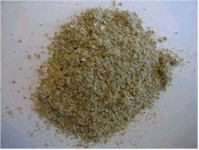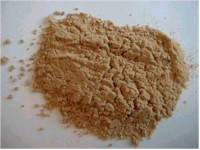|
|
Tribulus Terrestris Extract: Supplement Fact or Fiction
by Bryan Haycock M.Sc., CSCS
bryan@thinkmuscle.com
Please send us your feedback on
this article.
I first read of a tribulus terrestris product called Tribestan®,
which I believe was the first tribulus terrestris product marketed to
the public, in Dan Duchaine’s Underground Steroid Handbook. Since that time I
have accumulated mostly second hand accounts of how, and how well, it
works. Tribulus is an herbal supplement used since the late 70's in
Eastern Europe. It’s purported effects include increased luteinizing
hormone release and thus testosterone production, increased sperm
production, increased ejaculatory volume, and increased libido. In young
patients with a condition known as hypogonadism, an increase in pubic
hair has also been observed. All of these effects make tribulus an
interesting supplement indeed.
I should tell you at the onset that very little research has been
done on tribulus outside of eastern Europe let alone without some
association with a Bulgarian company called Sopharma. This makes getting
access to independent studies in English very difficult because they are
virtually non-existent. Most of the information I will use is provided
by Sopharma of Bulgaria. Many of you know that this is the company the
manufactures Tribestan®. This does not mean the data is necessarily
false, it simply needs to be kept in mind when interpreting the data.
Much of their research on tribulus terrestris was used to get patent
approval as well as to get the product registered for distribution in
the United States.
So why is there so little research done on herbal preparations with
medicinal purposes here in the US? For those of you not from the U.S. or
not familiar with the American Medical Model I will briefly
explain. Here in the U.S. we practice what is sometimes called
"rescue medicine". This refers to the fact that we put the
overwhelming majority of our funds and man hours into discovering ways
to save people from the brink of death. Regardless of what you here on
the morning news, there is only a minute percentage of federal moneys
spent on exploring preventative medicine. We claim bragging rights to a
considerable number of medical innovations all designed to cheat fate
(A.K.A. death). If nature has dealt you a bad hand you can count on the
American Medical Association to do everything in their Hippocratic power
to slip you an Ace or two under the operating table. More often than not
this simply prolongs the suffering of the sick as they "enjoy"
the sometimes involuntary treatment from medical doctors.
Recently there has been a push from the public to explore more
holistic approaches to health. The popularity of "alternative
medicine" has been growing every year for the past decade or more.
Where are we getting this alternative medicine? From countries in
Eastern Europe, the Middle East, and of course the Far East. In
countries such as China, Bulgaria and the former Soviet Union plants
with medicinal properties are taken very seriously. Scientists involved
in this research are just as respected as those involved in more
traditional "western" medicine, unlike here in the U.S. where
they are often labeled as quacks. OK, time to step down form my soap
box. Let me finish by saying that things are changing here in the U.S.
and I wouldn’t be surprised to see a dramatic paradigm shift in the
next couple of years as herbal medicine shows itself profitable to
pharmaceutical companies. After all, where do you think the exorbitant
amounts of money spent on health care go? That’s right, into the
pockets of those working in the health care and pharmaceutical industry.
The original purpose for tribulus terrestris extract was as a
"tonic" to treat sexual dysfunction. In animal husbandry
studies tribulus extract was shown to stimulate rutting behavior (i.e.
attempting to score) in rams as well as boars. When the supplement
Tribestan® was given to healthy men (Milanov, 1981) in a dose of 750
milligrams per day for five days, LH and testosterone were elevated 72%
and 40% respectively. As you might expect, estradiol was also elevated.
In fact estradiol was elevated by 81%! The increase in testosterone is
obviously what all the fuss is about, nevertheless, you can’t ignore
the fact that whenever you increase testosterone you are going to
increase aromatization and therefore estrogen levels. To put these
changes in hormone levels into perspective, the reference range for
testosterone in men is between 300 - 1,000 ng/dL. The subjects in this
study started out with an average of 600 ng/dL and ended up with about
850 ng/dL. This is still well within the "normal" range for
men. Estradiol on the other hand went from normal levels of about 76
pg/ml to significantly elevated levels of 137.5 pg/ml. This is well
above normal levels which range from about 20-80 pg/ml in men.
So why haven’t people been reporting symptoms of elevated estrogens
like bloating and gynecomastia from the use of tribulus products? My
first response would be to say because they are not actually
experiencing elevated estradiol levels due to the poor quality of most
tribulus terrestris supplements. Lab tests (paid for by Sopharma) on
several manufacturers of raw tribulus terrestris extract show that the
majority don’t contain sufficient levels of protodioscine. Sopharma
also went on to test various supplements said to contain tribulus
terrestris extract and found most all of them to contain far less
than that found in Tribestan®. Another important issue to point out is
that tribulus terrestris as an herbal supplement is not the same thing
as tribulus terrestris extract. Plain tribulus terrestris looks
like any other herb that has been chopped up finely and dried, no
different than the dried herbs you buy to cook with (Fig. 1). Tribulus
terrestris extract looks much different. It is a reddish brown
powder (Fig. 2).
 |
 |
| Figure 1. Raw tribulus
terrestris |
Figure 2. Tribulus terrestris
extract |
Tribulus extract is extremely safe and appears to have no undesirable
side effects. One of the reasons Tribulus extract doesn’t seem to have
any apparent side effects in research subjects is because it doesn’t
push testosterone above "upper" normal levels. The body is
seemingly up-regulating aromatization to accommodate for the increase in
LH and testosterone. No studies have been done to date to support this
but from the changes in testosterone and estradiol respectively I would
say there is a good chance this is in fact what is happening.
So to get the most out of tribulus extract I would suggest that you
make sure you are in fact taking tribulus terrestris extract. Now
that you know what it looks like you should have no problem finding a
product that at least appears to be genuine. Although Chrysin has not
exactly performed as expected, if you take enough of it you should be
able to reduce the amount of aromatization caused by tribulus extract
and hopefully increase testosterone levels slightly more. 1.5 -2 grams
per day is a good place to start with Chrysin. Obviously an
aromatase inhibitor like Arimidex would be perfect if you have access to
it. ˝ tablet per day would be sufficient for the first week, then ˝
tablet every other day for the duration of time using tribulus extract
should be enough. You don’t want to completely inhibit aromatase
because that will lead to a reduction in GH and IGF-1 levels. As a rule
of thumb take as little Arimidex as you need to control symptoms.
Prohormones such as androstenediol and/or norandrostenediol should
theoretically also be helpful when taking tribulus extract. To be more
precise, tribulus should help prevent or postpone the reduction of LH
caused by chronic prohormone intake. I am also assuming that you would
be using prohormones to elevate testosterone levels not just to
"help" your workouts. This usually requires higher doses of
prohormones taken throughout the day and can be accompanied by the usual
unwanted side effects. Keep in mind that we are talking about taking
750-1,500 milligrams of pure tribulus extract per day to be effective.
Taking less will simply be a waste of money for most people. Upon
discontinuation of the tribulus product you should taper your dose over
a period of at least 2-3 weeks.
Summary of Tribulus terrestris extract
|
Compound: |
Tribulus terrestris extract
NOTE: The following comments and recommendations are valid only
with respect to tribulus products containing tribulus terrestris
extract standardized for at least 45% steroidal saponins of the
furostanol type. Of these saponins protodioscine should
predominate. |
|
Reported Benefit: |
Marketed as a "testosterone booster", claims include
increased Luteinizing Hormone (LH) release and thus increased
testosterone production. Unfortunately claims about tribulus
products usually insinuate that you will get steroid-like effects
from this product. Even the most potent tribulus products will
not approach the effectiveness of most synthetic androgens for
building muscle. |
|
Have controlled studies been performed? |
Yes, but most research was done in Eastern Europe and was
sponsored/produced by Sopharma, a manufacturer of the product.
Their research shows tribulus terrestris extract to have a
significant effect by increasing LH (~72%), testosterone(~40%),
and estradiol(~80%). |
|
Mechanism of action: |
Tribulus Terrestris extract has been shown to stimulate LH
release from the pituitary gland. It may also have some peripheral
effects as manifested by increased pubic hair in some hypogonadal
test subjects. It is speculated that the metabolites of
protodioscine may also have mild androgenic properties. The exact
mechanisms are still vague and current explanations are
speculative at best. |
|
Interaction with other nutrients? |
No |
|
Effective dose: |
Effective doses used in clinical settings are 750-1500
milligrams per day.
NOTE: I refer to studies using Tribestan®. Other supplements
with lower concentrations of active steroidal saponins would
require larger doses to achieve the same effect. |
|
Proper dosing schedule: |
Take 3-4 times per day with meals. As the half-life of
protodioscine is very low (~2 ˝ hours), a more frequent dosing
schedule might increase effectiveness.
NOTE: In order to have an effect on male fertility
supplementation must continue for at least 90 days. |
|
Toxicity? |
None |
|
Conditions where may be effective: |
May be most effective at correcting a decline in LH pulsatile
amplitude and/or frequency. Should be effective at returning
testosterone to "normal" levels in situations where
testosterone is abnormally low such as in chronic or acute
hypogonadism, after a steroid cycle, while overtraining, with age
associated declines in testosterone, and during extreme and/or
prolonged dieting.
NOTE: Taking an aromatase inhibitor should significantly
enhance the effectiveness of tribulus terrestris extract to
elevate serum testosterone. |
References for Tribulus terrestris extract:
- Vankov, S. Apropos of Tribestan pharmacology. Scientific-technical
Report, 1980.
- Viktorov, Iv., D. Kaloyanov, Al. Lilov, L. Zlatanova, Vl.,
Kasabov. Clinical investigation on Tribestan in males with disorders
in the sexual function MBI, 1982 (in print).
- Gendjeiv, Z. Studies on Tribestan carcinogenicity.
Scientific-technical report, 1981.
- Koumanov, F., E. Bozadjieva, M. Andreeva, E. Platonova, V. Ankov.
Clinical trial of Tribestan. Exper. Med. 1982, 2.
- Milanov, S., E. Maleeva, M. Tashkov. Tribestan effect on the concentration of some
hormones in the serum of healthy subjects (Company
documentation)(1981).
- Nikolov, R. Neuropharmacological Study on Tribestan.
Scientific-technical report, 1981.
- Protich, M., D. Tsvetkov, B. Nalbanski, R. Stanislavov, M.
Katsarova. Clinical trial of Tribestan in infertile males.
Scientific-technical Report, 1981.
- Tanev, G., S. Zarkova, Toxicological studies on Tribestan.
Scientific-technical Report, 1981.
- Tomova, M., R. Gyulemetova, S. Zarkova. An agent for stimulation
of sexual function. Patent (11) 27584 A61K35/1978.
- Tomova, M., R. Gyulemetova, S. Zarkova - License (11) 27584 AGIR
35/1978.
- Tomova, M., R. Gyulemetova, S. Zarkova at al., License
68428/18.I.1985.
Please send us your feedback on
this article.
by Bryan Haycock M.Sc., CSCS
bryan@thinkmuscle.com
|
 |
|
